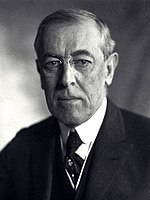| ||||||||||||||||||||||||||
All 13 Kentucky votes to the Electoral College | ||||||||||||||||||||||||||
|---|---|---|---|---|---|---|---|---|---|---|---|---|---|---|---|---|---|---|---|---|---|---|---|---|---|---|
| ||||||||||||||||||||||||||
 County Results
| ||||||||||||||||||||||||||
| ||||||||||||||||||||||||||
| Elections in Kentucky |
|---|
 |
|
|
The 1916 United States presidential election in Kentucky took place on November 7, 1916, as part of the 1916 United States presidential election. Voters chose thirteen representatives, or electors to the Electoral College, who voted for president and vice president.
Ever since the Civil War, Kentucky had been shaped politically by divisions created by that war between secessionist, Democratic counties and Unionist, Republican ones,[1] although the state as a whole leaned Democratic throughout this era and the GOP had carried the state only once[2] – by a very narrow margin in 1896[3] when northern parts of the state were affected by hostility towards William Jennings Bryan, and state native John M. Palmer drew votes from the Democrats.[4]
Unlike the other former Confederate states, Kentucky was not able to disfranchise its relatively small black population which had shrunk significantly in the late nineteenth century due to migration out of the South, in the 1900s,[5] and this helped the Republicans carry the governorship in 1907 and narrowly fail to do so in 1915. Reunited after the 1912 debacle between William Howard Taft and Theodore Roosevelt, the GOP under Charles Evans Hughes visited the state in September and thought it could win a substantial plurality.[6] Wilson also visited Kentucky in September,[7] though for a large part of the fall the Republicans continued to believe they possessed a chance of carrying Kentucky's thirteen electoral votes,[8] after another campaign tour with Theodore Roosevelt.[9] However, by the second week of October, polls were suggesting that Wilson would comfortably carry Kentucky.[10] By the end of the month, polls suggested that Wilson had five-eighths of the vote over Hughes,[11] which if maintained would have been the best Democratic performance in the state between 1872 and 1960.[3]
Ultimately, Wilson carried the state by 5.41 percent, an improvement of around three points on the narrow victories of Alton B. Parker and William Jennings Bryan in Kentucky's previous three two-party contests, although much less than the final polls.
- ^ Sullivan, Robert David; ‘How the Red and Blue Map Evolved Over the Past Century’; America Magazine in The National Catholic Review; June 29, 2016
- ^ Phillips, Kevin P.; The Emerging Republican Majority, p. 350 ISBN 978-0-691-16324-6
- ^ a b "Presidential General Election Results Comparison – Kentucky". Dave Leip’s U.S. Election Atlas.
- ^ Harrison, Lowell Hayes (October 31, 2018). A New History of Kentucky. University Press of Kentucky. p. 268. ISBN 9780813176307.
- ^ Klotter, Jeames C. Kentucky: Portrait in Paradox, 1900-1950. pp. 196–197. ISBN 0916968243.
- ^ "Make Railroad Bill a Republican Issue: Hughes Managers Are Canvassing Sentiment on Law Among Labor Men". New York Times. September 6, 1916. p. 1.
- ^ "20,000 Cheer Speech as Wilson Accepts: Formally Opens Campaign by Defending His Policies. Demands "Big America", Calls Republican Party "a Practical and Moral Failure"". The Washington Post. September 3, 1916. p. A1.
- ^ Curtis, Sumner (October 7, 1916). "Campaign Keyed High: Contest Becoming More Complex as It Progresses". Special to the Washington Post. p. 1.
- ^ "Seven Roosevelt Speeches Pledged: Colonel Will Make Special Effort, with Mr. Hughes, in Kentucky". New York Times. October 10, 1916. p. 24.
- ^ "Wilson Making Gains: Nation-wide Poll Shows Swing Toward the President". Special to the Washington Post. October 8, 1916. p. 8.
- ^ "Wilson Retains Lead in Kentucky and Tennessee". New York Times. October 29, 1916. p. 16.

